There’s something wrong with the Political Compass.
I was trying, earlier this year, to write an article about the fundamental values of the left and the right. The more I wrote the more the article unravelled itself, line by line. Eventually, I made the embarrassing discovery that I didn’t really understand what right wing was. Then I made the more relieving discovery that lots of people don’t really know what right wing is – and it hasn’t necessarily had only one meaning throughout history.
Several attempts have been made to compact the political landscape into a simple graphical form. The left-right dichotomy dates back to the French revolution. It originally derived from the parliament’s seating arrangements and became a loose proxy for the commoners versus the aristocrats, the poor versus the wealthy, the have’s versus the have-not’s.
The Political Compass is the most popular expansion of the left-right spectrum. It built on an earlier work by Hans Eysenck on “political personalities”. In case you haven’t seen it, The Political Compass is a graph that plots left-right on one axis versus authoritarian-libertarian on the other.
In my brief research, I did also see David Nolan’s ‘Nolan Chart’ (which I won’t bother explaining, because I don’t think it’s very good), but my personal favourite was Brian Patrick Mitchell’s less well-known archê/kratos plot. I liked Mitchell’s idea so much that I purchased his book, 8 Ways of Running the Country. It is a fantastic read that I highly recommend. He cleared up for me that the left-right dichotomy has shifted definition over the years, viewed by some as having fascism at the far right, and by others as having individualists at the far right.
Mitchell developed his own plot of ‘archê’ meaning recognition of rank (right to rule), versus ‘kratos’ meaning use of force (might to rule). These two Greek words are the roots of many political words like anarchy, monarchy, aristocracy (aristos-kratos) and democracy (demos-kratos).
However, Mitchell’s plot seems flawed in a similar way to the Political Compass. My basic problem with them is the presence of logical “no go” zones. With the political compass, it seems clear that you can’t have a far-right libertarian or a far-left libertarian. Neither far right nor far-left are achievable without being authoritarian. Similarly, on Mitchell’s plot, it makes no sense to have maximum archê with zero kratos. How can you believe in the right to rule but not the power to act on it?
Now, I’m an engineer, which means three things. First, I like graphs. Secondly, I like spreadsheets. Third, my degree taught me a lot about gearboxes and next to nothing about politics. So please forgive my residual ignorance as I relate my humanities-lite journey that nevertheless ends in what I think is a pretty good idea.
People in the humanities can tend to use graphs, or ‘diagrams’, without carefully defining their variables. Which I think is why they’ve ballsed it up. You see, they’ve all been using Cartesian grids. Cartesian graphs are intended for plotting two independent variables, which is not applicable to this situation.
Let’s suppose that the classical left-right works, to a degree, because left wing and right-wing are a trade-off. On the right is 100 per cent right wing; on the left is 100 per cent left wing. It is implicit that you cannot be both – the more left wing you are, the less right wing you must be, and visa-versa. The left-right spectrum has two variables, it is a line, but in two-dimensional space:
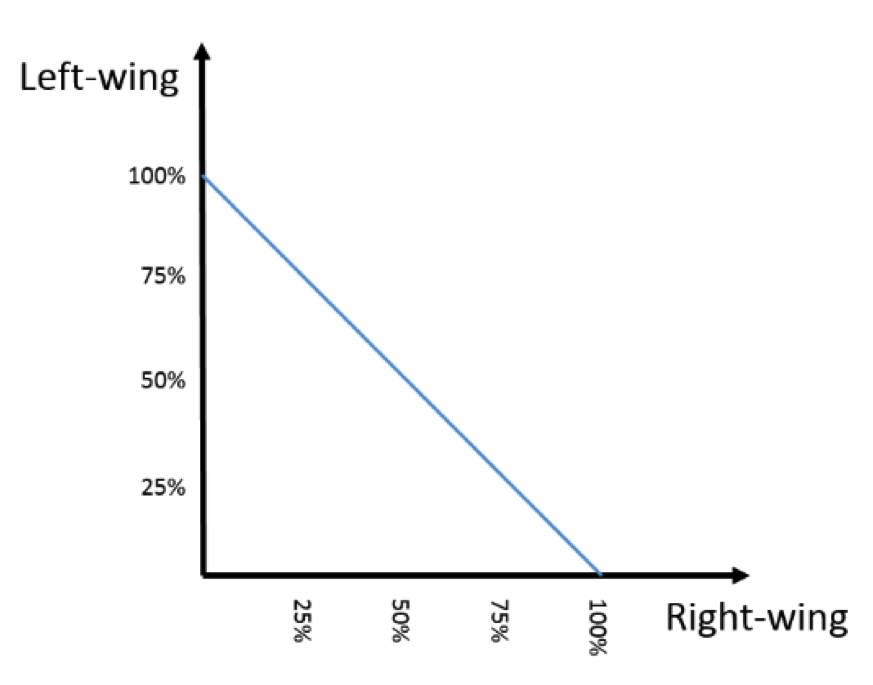 The equation for such a trade-off is:
The equation for such a trade-off is:
Leftyness + Rightyness = 100 per cent
When adding in the third variable, libertarian, the makers of the Political Compass chose to treat it as an independent variable. But in my opinion, it clearly isn’t. The more libertarian you are, the less right- or left-wing you can be. I’m not saying there aren’t left- and right-libertarians along the way, but the 100 per cent libertarian position would be anathema to both the right and the left, so there’s a trade-off involved.
If it is a trade-off, then perhaps we should try plotting the following equation:
Leftyness + Rightyness + Libertarianness = 100 per cent
If you do this, the graph that results is something known in engineering circles as a three-phase concentration diagram. It’s a triangle. What I am calling The Political Triangle. A comparison between three approaches is shown below:
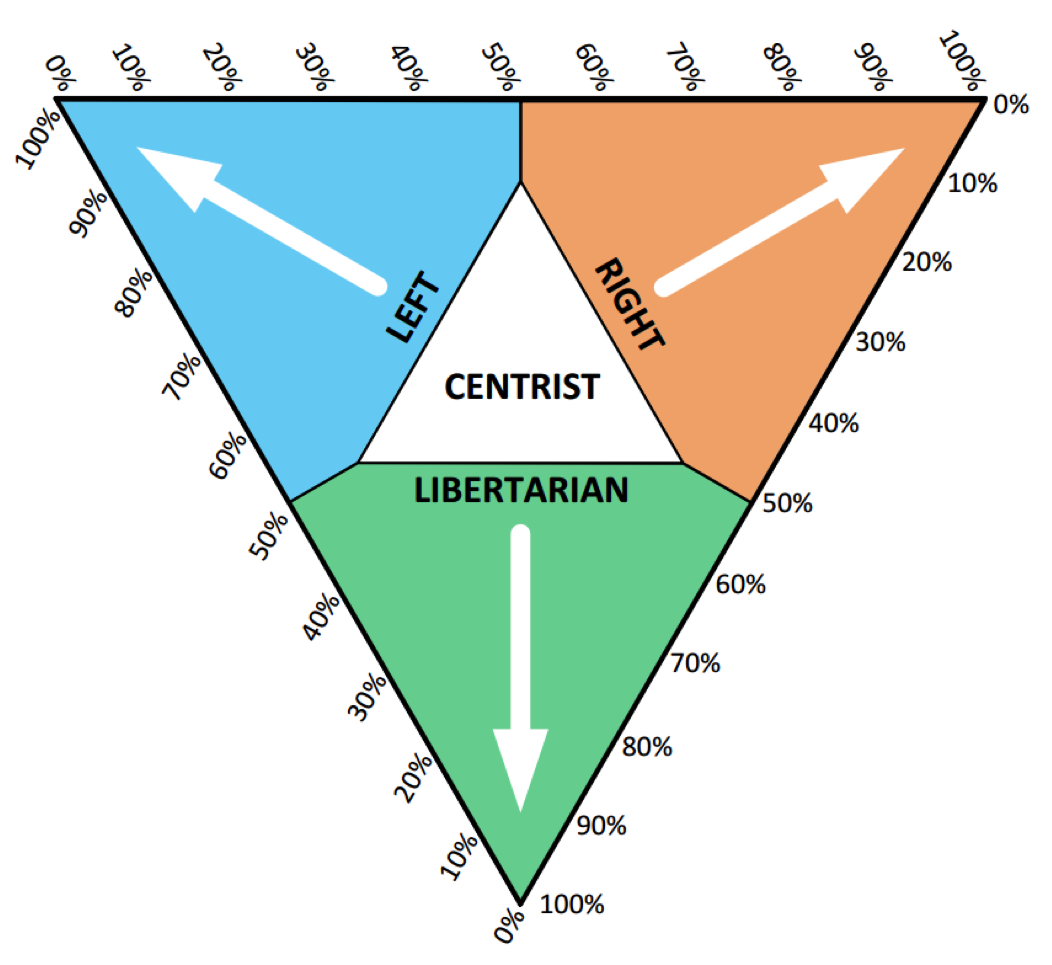
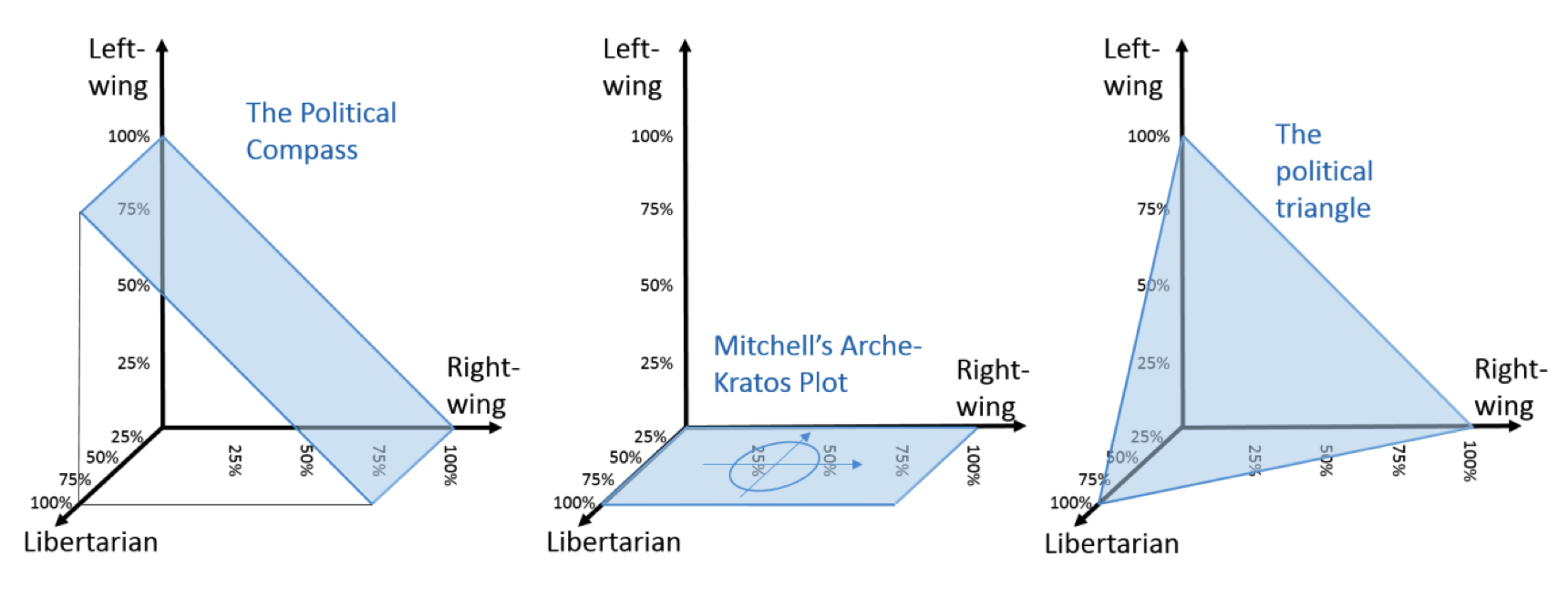 So that’s my basic thesis – there’s a three-way trade-off. But what are the ‘variables’ being exchanged? And what makes them a trade-off?
So that’s my basic thesis – there’s a three-way trade-off. But what are the ‘variables’ being exchanged? And what makes them a trade-off?
Here is where I decided to empty my mind of any current notions of left, right and libertarian, and tried to dig down to the most fundamental perspective. I came up with three variables:
- Equality
- Autonomy / Freedom
- Nobility / Hierarchy
“Equality” ranges from inequality (0 per cent), through equality before the law, then equality of opportunity, and eventually complete economic equality (100 per cent), or “equality of outcome” as Jordan Peterson calls it.
“Autonomy” would be 0 per cent in a totalitarian world. As it increases, there is first limited personal freedom within a ‘private’ domain, then economic freedoms: freedom to succeed or fail in a regulated market, then a free market, and eventually complete personal freedom even in the public domain, which annihilates rule of law and yields complete anarchy (100 per cent). This variable is the inverse of the “size of government”—it would take a large government to destroy all autonomy and no government yields complete autonomy.
“Nobility” is the right to have authority. At the 0 per cent end of the spectrum, no one is allowed any authority over anyone else. As there is more nobility it is initially merit-based; people who are gifted for ruling should be able to rule. Then right to rule is based on less meritorious things, like how much money someone has (aristocracy). Eventually, you have heredity: kingly dynasties, god-emperors, caste-systems and slavery, in which people are born into their irrevocable station in life. Nobility is “social-immobility”, if you like.
That these are a trade-off is not immediately obvious. But if you think about it, equality cannot coexist with either of the other two. Nobility is an active inequality, the inequality that is inherent when some people have authority and others don’t. Autonomy is passive inequality, inequality is created because people are free, and freedom includes the freedom to be unequal.
So, there you have it. The political triangle. I’ve put some labels on it, in approximate locations. Observe that at every point on the graph, the three variables add up to 100 per cent.
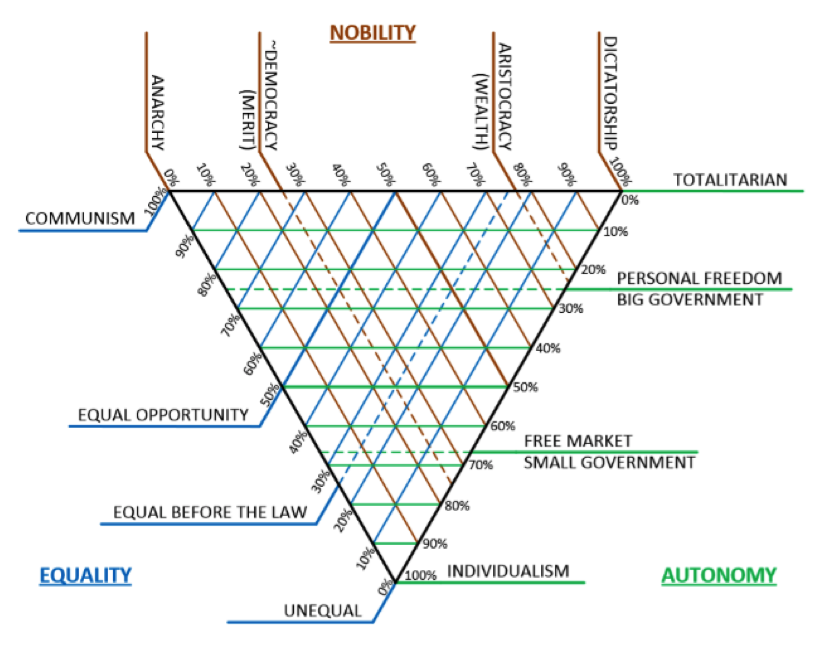 There’s also an alternate perspective for understanding the trade-off, built around the question: “On what basis do you decide what you do?” There are three answers:
There’s also an alternate perspective for understanding the trade-off, built around the question: “On what basis do you decide what you do?” There are three answers:
- Autonomy = Self-rule (obey yourself)
- Nobility = Rule of man (obey people who tell you what to do)
- Equality = Rule of law (obey a rulebook that tells you what to do)
A school classroom is a great microcosm to conceptualise this, where there is a trade-off between student autonomy, the teacher’s authority, and written rules, that governs what happens.
This Political Triangle is certainly not infallible. It simplifies complex systems, which necessarily means a loss of resolution on important issues. Nevertheless, it works really well for my brain, so maybe it will for yours also.
What do you think? Do you have improvements or clarifications? And what would you call yourself – top-rightist? Bottomist? Or perhaps you’re an E35N25A40 like me.
Nick Kastelein is a Christian and a conservative who grew up and lives in Adelaide where he works for an engineering consultancy.
Illustration: Etsy.
Got something to add? Join the discussion and comment below.
Got something to add? Join the discussion and comment below.
Get 10 issues for just $10
Subscribe to The Spectator Australia today for the next 10 magazine issues, plus full online access, for just $10.

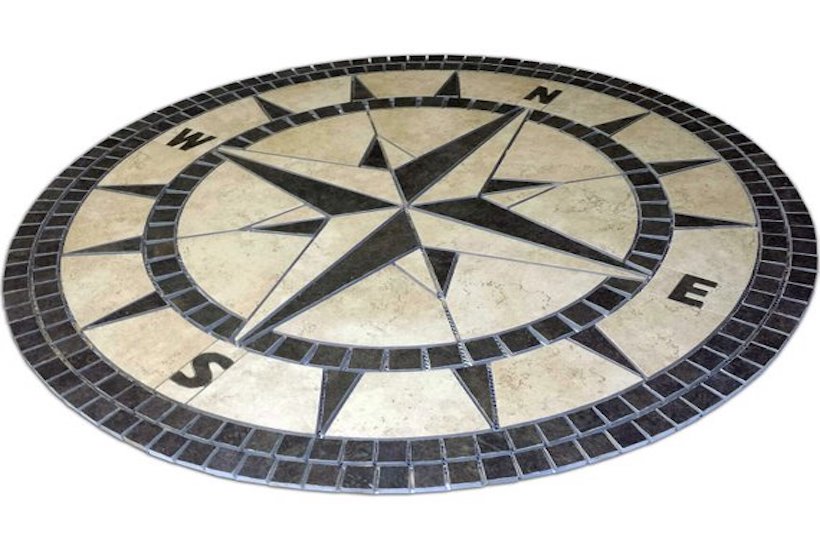
























Comments
Don't miss out
Join the conversation with other Spectator Australia readers. Subscribe to leave a comment.
SUBSCRIBEAlready a subscriber? Log in